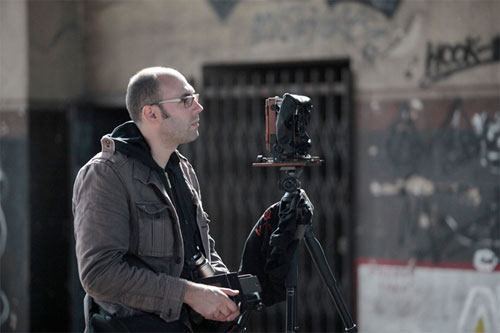Thomas Jorion (b. 1976, lives in Paris) photographs urban ruins and condemned buildings, spaces that no longer serve the purposes for which they were built. His work explores the built environment in a state of entropy, inviting viewers to reflect on the relationship between the material and the temporal.
My work is based on our perception of time, how it passes and especially its lack of linearity. Some places seem frozen as time passes by. While our society is developing and changing very rapidly, these places are submitted to a distorted passing of time. They seem to be lifeless or in a waking state, although in reality they have their own link with time. I travel the world with one idea in mind, to find and show timeless islands. I choose to enter closed and abandoned places formerly alive, and often places of leisure or prestige to capture and share them. My fascination for the esthetic of abandoned places is the extension of an older tradition. The Romantics enjoyed strolling amidst the ruins of long lost civilizations. Centuries earlier, painters such as François de Nomé (1592 – 1623), Giovanni Battista Piranesi (1720-1778) and Hubert Robert (1733 – 1808) dedicated part of their work to these forgotten places. Somehow my photos are part of this process. The existence of timeless islands stems from a variety of contemporary phenomena. Though each of these islands has a particular origin depending on its location, all eventually evoke the disappearance of men. In Japan, the line between leisure and consumption is often blurry. Leisure activities that are deemed old-fashioned are disposed of – similar to those handkerchiefs, the “nuigishi,” given out for free on the streets by pretty young ladies. An example of this occurence (occurrence – deux R) is the three-storied, 108-lane bowling alley in a Tokyo suburb. Being out of use for some time, it soon is to be demolished. The expansion of new forms of leisure activities has also led to a booming hotel industry. Better and cheaper flight connections and the growing mobility of global citizens made the world a village, with every destination easy to reach. The province of Izu, which used to be a popular summer destination for the Japanese, is now competing with international destinations as in China or Korea. Hotel complexes or amusement parks now open for business or shut their gates according to short-lived trends in the tourism industry. In America the consequences of the economic crisis have been more disastrous than anyone could hardly have imagined. In the vast landscape of the United States, the possibility to build on new land is considered limitless. The habit of constructing new buildings instead of renovating old ones has proven rather catastrophic for the country. The dramatic consequences can be seen in cities such as Detroit MI, where the “white flag” phenomenon has made matters even worse. Other cities, such as Memphis, TN, or Bridgeport, CT have followed suit. Those cities’ entire cultural and social identities have decayed into ruin. The first places to have become useless for society were theaters, movie theaters, sport centers, schools and churches. Health care institutions, public housing, and judicial systems suffered, too… The failure of American Utopias, photographed by Joel Sternfeld in the late 70s, was already heralding deeper phenomena observed today. On the old continent, the reasons are multiple and the consequences are often the same. Struck by a major structural transformation from industrial to post-modern societies many countries had to turn away from their heavy industry. Gigantic textile factories in Northern Italy have completely disappeared, even sumptuous villas of industrialists were forsaken and left to decay. Twenty years after the reunification this development can also be seen in Germany, where factories became completely unsuitable for the global economy and whole regions became deserted due to migration. There is no denying that these abandoned places now cover all continents and in the name of the profit motive tends to amplify this phenomenon. As for my photographic practice, I wish to conserve the rawness of the places that I observe. This represents a challenge. The frame must be arranged in accordance with the layout of the space and the available light. For me, this reinforces the immaculate and timeless aspect of the place. My use of a large format camera allows me to make sharp and detailed images that contain a variety of focal points, textures, and depths. Capturing the richness of such pictures takes much time, which in turn reduces the number of photographs I can take. The choice of color film is important because it anchors the place within the present moment and allows for a faithful rendering of things seen. This eliminates the austere quality of certain spaces. For example, in the Piedmont theater, the blue, yellow, and brown are muted and soft colors, but they correspond well together to reveal a new beauty.
Source: www.thomasjorion.com
